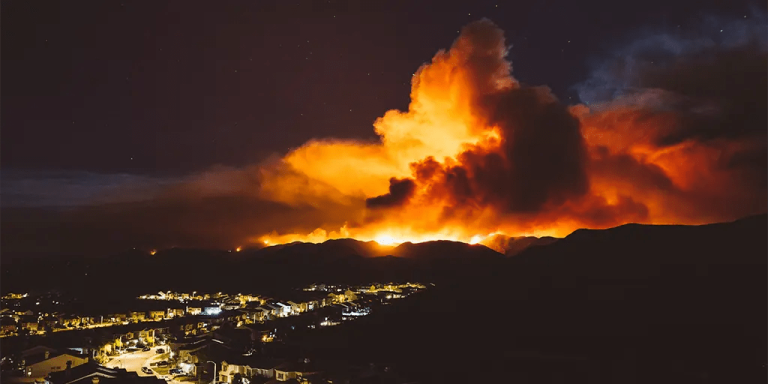Jim Steele
Start by learning about Southern California’s natural drying. Its Mediterranean climate means little rain in the summer and limited rainy seasons in the winter. The region's three deserts attest to its dry climate.
Therefore, the vegetation around Los Angeles consists primarily of one-hour fuel, which dries in as little as 60 minutes, and consists of dead grass, leaves, and pine needles, and 10-hour fuel, which consists of dead twigs, 1/4 inch in diameter. Able to retain moisture, but briefly, the material is essentially a fire starter.
While storms can make vegetation temporarily fire-resistant, once the rain stops, the drying process begins. Dead grass and branches may become Highly flammable within 12 to 24 hours. Due to natural climate fluctuations such as El Niño, last year's above-average rainfall increased the amount of 1-hour and 10-hour fuel available compared to this drier year
The rainy season in Los Angeles lasts from December to February, but it rains on average only 6 days per month. Therefore, there are typically about 24 dry days each winter, and vegetation can quickly become flammable. The duration of natural summer droughts or the timing of the first winter rains are not important for Southern California's basic drought.
Although climate alarmists like Michael Mann blame the fires on global warming, December droughts are not unusual. In fact, on January 9th There was an increasing trend in rainfall in the 30 days before the fire, but this was clearly not a factor.

Additionally, the winter rainy season coincides with the period of Santa Ana winds. The wind originates from the cold high desert and blows from the mountain slopes to the warm ocean. As they descend, the winds warm and dry further, relative humidity is often below 10%, and vegetation dries out rapidly.
When determining the safety of prescribed burning, the USDA considers the likelihood of fire spread to be 100% when the relative humidity is 25% or less. It's no wonder the National Weather Service issues warnings of hazardous conditions when weather systems combine to increase drying winds. Santa Ana is predicted to be its strongest in a decade.
The last major fire in the area — the Thomas Fire in December 2017 — was started by Santa Ana winds that caused sparks on power lines.
Knowing that natural, deadly fire dangers are always looming for a growing population, the question is whether city and state governments can be better prepared to minimize fires and more effectively contain their spread in Southern California. When a fire spreads into a densely populated neighborhood, one burning building can radiate enough heat to ignite neighboring buildings, causing the entire neighborhood to burn.
As a result, ordinances created in recent decades to create defensible space around homes have been enacted to keep the height of grass and native shrubbery within 200 feet of a building to less than 3 inches. Roofs on new and replacement buildings must be fire-resistant. But how well these laws are being enforced is unclear. It's also unclear whether sufficient brush management is being maintained on adjacent public lands to slow the fire's spread to more populated areas. Regardless, the fire spread to enough homes to cause the entire neighborhood to be destroyed.

The cause of the wildfire has not yet been determined, but it is certainly not caused by a lightning strike. During high winds, downed power lines are a common source of ignition and can be suspicious. However, unlike major cities like Los Angeles, homelessness-related fires have increased, rising to 13,909 fires in 2023, doubling since 2020. But arsonists also started other fires, such as the Kenneth Fire, a fire in Los Angeles.
In addition to ineffective policies to address homelessness, many believe government spending priorities have exacerbated the fire threat. For example, Los Angeles increased spending on homeless services to $1.3 billion. By comparison, Los Angeles Mayor Karen Bass and Governor Newsom cut their fire protection budgets by $18 million and $100 million, respectively.
Finally, water management policies may also have compromised the ability to control fires because some hydrants were running out of water. The Santa Ynez Reservoir in Pacific Palisades has dried up and is closed. Could money cut from the fire protection budget be used to install more water storage tanks to offset the reduction in water supply from the reservoir? Should the government increase its budget to build more reservoirs. Could a system using seawater be researched to stop such devastating fires?
Climate alarmists like Michael Mann claim it's an increase in carbon dioxide2 Creating a drier environment that leads to bigger fires. But the data doesn’t support his alarmism.
Increases in property damage from wildfires are better correlated with population growth and the expansion of power grids vulnerable to strong winds. Increases in 1-hour fuel and 10-hour fuel are associated with larger fires due to land disturbance and poor land management. Increases in the homeless population are associated with more fires.
Blaming climate change for these disasters only diverts attention from the actual causes. Manufactured products related to rising carbon dioxide2 Wildfires should be ignored. Governments must adopt solutions that truly protect people and their property from the unstoppable natural conditions that lead to devastating fires.
James Steele is a biologist, author, and former director of San Francisco State University's Sierra Nevada campus. He is a member of CO2 alliance.
Relevant
Learn more from Watts Up With That?
Subscribe to have the latest posts delivered to your email.
